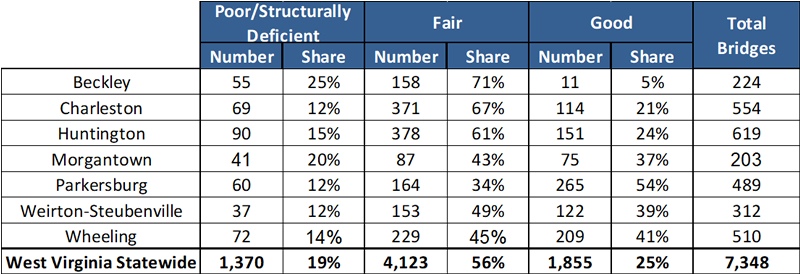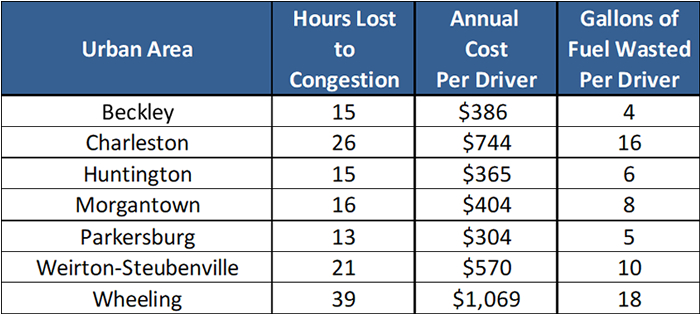FOR IMMEDIATE RELEASE
10:00 a.m. EDT, Tuesday, April 8, 2025
Contact:
Rocky Moretti (202) 262-0714
Carolyn Bonifas Kelly (703) 801-9212
Click here for the full report, news conference recording and infograhics.
WEST VIRGINIA ROAD & BRIDGE CONDITIONS, CONGESTION & SAFETY ADDRESSED WITH ADDITIONAL STATE & FEDERAL FUNDS; BUT INFLATION IN HIGHWAY CONSTRUCTION COSTS THREATENS FURTHER IMPROVEMENTS TO ROAD & BRIDGE CONDITIONS, TRAFFIC SAFETY & CONGESTION
Wheeling, WV – While additional state and federal transportation investments are enabling West Virginia to make needed improvements to its transportation system, the state’s ability to keep pace with growing transportation needs is threatened by a significant increase in inflation of highway construction costs and the reduced purchasing power of motor fuel tax revenues, due to improved vehicle fuel efficiency, and the adoption of hybrid and electric vehicles. This is according to a new report from TRIP, a national transportation research nonprofit based in Washington, DC, which looks at the condition, reliability, safety and funding needs of West Virginia’s roads, highways and bridges.
The TRIP report, “Keeping West Virginia Moving Forward: Progress and Challenges in Achieving a 21st Century Transportation System,” finds that throughout West Virginia, nearly one-third of major roads are in poor or mediocre condition, the share of bridges (20 feet or more in length) rated poor/structurally deficient is the highest in the nation, increasing traffic congestion impedes personal and commercial mobility, and the state’s traffic fatality rate is among the highest in the U.S.
In the Wheeling area, 31 percent of major roads are in poor or mediocre condition, costing the average driver $493 annually in extra vehicle operating costs (VOC). Extra vehicle operating costs total $577 million statewide and include accelerated vehicle depreciation, additional repair costs, and increased fuel consumption and tire wear. Statewide, nearly one-third of major locally and state-maintained roads are deteriorated, with eight percent in poor condition and 22 percent in mediocre condition.

“The TRIP report is a good tool for measuring the condition of highway systems,” said West Virginia Transportation Secretary Todd Rumbaugh, P.E. “We appreciate the data that they collect and the way it serves the public.”
Fourteen percent of bridges in the Wheeling area are in poor/structurally deficient condition, meaning there is significant deterioration to the bridge deck, supports or other major components. Statewide, 19 percent of West Virginia’s bridges are rated poor/structurally deficient – the highest share in the U.S. Most bridges are designed to last 50 years before major overhaul or replacement, although many newer bridges are being designed to last 75 years or longer. In West Virginia, 30 percent of the state’s bridges were built in 1969 or earlier. 
Rumbaugh said that over the past five years, the West Virginia Department of Transportation (WVDOT) has invested hundreds of millions of dollars in addressing its bridges. “Poor and structurally deficient does not mean unsafe,” Rumbaugh said. “We would not ask our citizens to cross any bridge we would not willingly cross ourselves.”
Nevertheless, Rumbaugh said, investing in bridge maintenance and improvement remains one of the WVDOT’s top priorities. “Our goal is to get the number of poor bridges down below 10 percent,” Rumbaugh said.
From 2019 to 2023, 1,340 people were killed in traffic crashes in West Virginia, an average of 268 fatalities per year. The state’s 2023 traffic fatality rate of 1.64 fatalities for every 100 million miles traveled was the fifth highest in the U.S. and higher than the national average of 1.26. The traffic fatality rate per 100 million vehicle miles of travel in 2022 on West Virginia’s rural non-Interstate roads was nearly double that on all other roads in the state (2.41 vs. 1.25). Nationwide, traffic fatalities began to increase dramatically in 2020 even as vehicle travel rates plummeted due to the COVID-19 pandemic, and the number of fatalities continued to increase in 2021. The number of fatalities in West Virginia increased from 260 in 2019 to as high as 282 in 2021, before falling slightly to 267 in 2023. The state’s fatality rate per 100 million VMT increased from 1.36 in 2019 to 1.64 in 2023, an increase of 21 percent.

As in the nation as a whole, recent years have seen an increase in the number of fatal accidents on highways both nationwide and in West Virginia. Nationally, the spike is attributed largely to an increase in distracted driving, including the use of cell phones behind the wheel.
“Any death on a West Virginia highway is one too many,” Rumbaugh said. “Our goal continues to be zero fatalities on our state roads. As far as cell phone use goes, put it down. Look around.”
Congested roads, highways and bottlenecks choke commuting and commerce and cost West Virginia drivers $400 million each year in the form of lost time and wasted fuel. The average Wheeling driver loses 39 hours to congestion each year and $1,069 in lost time and wasted fuel due to congestion, while wasting 18 gallons of fuel annually.
To address a lack of adequate transportation funding, in 2017 the West Virginia legislature approved increases in the state’s motor fuel, registration fees, and taxes on new car purchases to support additional highway investment. State voters subsequently approved a referendum 73 to 27 percent allowing the state to borrow up to $1.6 billion to fund Governor Jim Justice’s Roads to Prosperity Initiative. As a result, West Virginia Department of Transportation (WVDOT) was able to increase the annual amount of investment in road, highway and bridge repairs and improvements by 67 percent from 2018 to 2023. Since 2018, WVDOT has repaved nearly 8,400 miles of roadway and made repairs to more than 3,400 bridges. However, the annual amount owed by the state in bond re-payments increased from $25 million in 2018 to $136 million in 2024. In addition to state funding, the Infrastructure Investment and Jobs Act (IIJA), signed into law in November 2021, will provide $3.6 billion in state funds for highway, bridge and transit investments in West Virginia over five years, including a 61 percent funding increase in FY 2022. Federal funds currently provide 38 percent of the revenue used by WVDOT to fund highway and bridge improvements. The IIJA expires on September 30, 2026. While the increased investment will be helpful, it does not keep pace with increasing inflation. The Federal Highway Administration’s national highway construction cost index, which measures labor and materials cost, increased by 45 percent from the beginning of 2022 through the second quarter of 2024.
“West Virginia is putting the increased state and federal transportation dollars to good use and making needed improvements to its transportation network,” said Dave Kearby, TRIP’s executive director. “But, the state’s ability to provide a smooth, reliable and safe transportation system depends on long-term, consistent and sufficient funding. A safe and reliable transportation system that is maintained in good condition and offers improved mobility and accessibility to meet the needs of West Virginia residents, businesses, and tourists alike, is critical to keeping West Virginia mobile and moving the state forward.”
“The West Virginia Business and Industry Council (BIC) supports the creation of additional revenue sources for the State Road Fund so the Division of Highways can maintain the state’s highway system, especially with the winddown of the projects funded by the Roads to Prosperity constitutional amendment,” said Mark Polen, chairman of BIC. “BIC made it one of our priority issues for 2025 to advocate for increasing funding to infrastructure development and maintenance, specifically for roads and bridges.”
“With the winddown of the Roads to Prosperity program, I’m very pleased to see West Virginia’s road conditions improving,” said Jason Pizatella, CEO of the Contractors Association of West Virginia. “We must, however, not take our eye off the ball when it comes to the need to keep investing in our state’s infrastructure. This report highlights the progress we’ve made but is also a sobering warning that there is still much work left to do: more roads to pave and more bridges to replace to get our highway system where West Virginians expect it to be.”